The Ultimate Guide To Lead Generation Strategies
in Marketing by Ncio

Every business needs sales to survive. But to have sales, you need leads. If you are struggling with generating leads for your business, then this article will provide you with everything you should know about lead generation strategies.
We’ll first discuss what lead generation is and why your business needs a lead generation strategy. Then, we’ll discuss lead generation funnels, how to get the most out of your lead generation efforts, and then main channels or lead generation strategies to generate high-quality leads for your business.
It’s going to be a comprehensive article. Let’s begin.
What is Lead Generation?
A lead is a person who has shown interest in the product or service you offer. They may become your paying customers in the future. There are two types of leads - marketing qualified leads (MQLs) and sales qualified leads (SQLs).
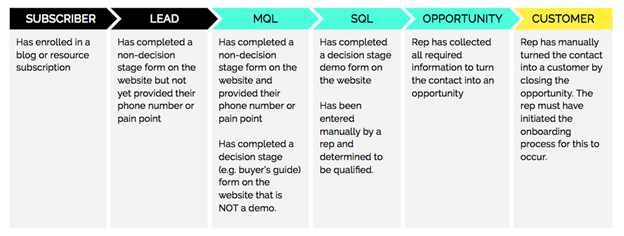
Source: Smartbugmedia
MQLs are leads that have shown interest in your company. They have provided you with their contact details to learn more about your product or services.
SQLs are your customers who are past the engagement state. You’ve given the product demo or service description or a sales presentation. Your next goal is to close the lead and convert them into a customer.
If we talk about B2C businesses, the distinction between SQLs or MQLs is not as important. The price point for the product or service is often lower, so the buyer journey is shorter. In B2B businesses where a product or service cost can be much higher, MQLs and SQLs matter.
Now let’s define the lead generation process. It’s essentially a process to stimulate an interest in your product or services. That can be done through promotional strategies like content marketing, Google ads, social media ads, and email marketing.
Whichever lead generation strategies you choose to promote your product, the principle everywhere remains the same—to showcase the value your product offers or how it can solve the problem your customers face.
Why Does Your Business Need Lead Generation?
You need to have a lead generation plan for your business. In this section, let’s look at those reasons. So, if you don’t have a lead generation strategy just yet, you’ll create your own and implement it.
1. You Expand Your Customer Base
People rarely buy a product or service after viewing it on your website the first time. Lead generation strategies help you convert more of those prospects who showed interest into customers. You achieve this by addressing their pain points and highlighting the benefits.
2. You Improve Cash-flow
In a B2B business, sales take time. Data shows most B2B businesses take more than a month to close a deal. For 10% of businesses, it takes more than a year to do that. So, it’s important to have a pipeline of leads to ensure you have a steady cash flow.
3. You Gain More Insights
You gather information about your audiences through lead generation strategies. So, even if a lead does not buy your product or service, you can still nurture those prospects. With the right approach, a portion of those leads will turn into customers. Moreover, by documenting the process, you can see what approaches you took to generate sales.
With a better understanding of the customer journey, you can improve your sales and marketing material. Hopefully, those insights will both shorten the customer journey and improve your conversion rates.
What is a Lead Generation Funnel?
Creating high-quality leads is a challenge, and many companies admit this. As described earlier, customers don't buy products immediately, especially in a B2B business. So, you need a road map or a system to qualify your customers in each stage of their buying journey.
That road map that segregates your audience based on the level of their interest in your product is called the lead generation funnel.
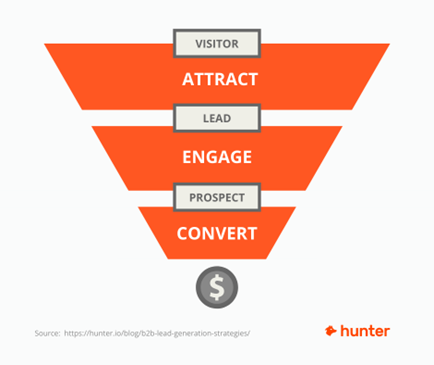
Source: Hunter.io
Creating a lead generation funnel is essential. You need to spend time developing effective customer acquisition funnels. We actually develop SaaS marketing strategies for our clients over at Crunch Marketing.
Lead Generation Funnel
The lead generation funnel has three stages: the Top of the Funnel (TOFU), the Middle of the Funnel (MOFU), and the bottom of the funnel (BOFU). Let’s quickly discuss the different parts of the lead generation funnel.
1. Top of the Funnel (TOFU)
At the top of the funnel, the main goal is to attract customers and build awareness of your product or services. You need to create a connection with your audience. That is done through your blog and website content, videos, social media platforms, and podcasts.
You can drive traffic to your content using various strategies. For example, you can add a YouTube QR code to your marketing materials or products. The customers can simply scan the code and watch your tutorials and demos. This is a great way to target the increasing number of mobile users.
2. Middle of the Funnel (MOFU)
In the second stage, your audiences become your MQL leads. So, business relationships are built here. You can do this by asking them to subscribe to your newsletters, getting them to download eBooks, or inviting them to free webinars.
Remember that business and marketing are about generating trust. Your goal is to develop a relationship with your leads, so they trust your company.
3. Bottom of the Funnel (BOFU)
At the bottom of the funnel, you can present your product or service. To encourage your prospects to make a purchase, you can provide case studies, give product demos, or show product reviews.
How Can You Get The Most Out Of Your Lead Generation?
Lead generation is a process. For every process to succeed, there should be a well-devised plan or a strategy behind it. So, let’s see the strategies that you can adopt for a successful lead generation campaign.
1. Outbound Marketing
Outbound marketing includes promoting your product via trade shows, sales webinars, paid ads, or you can use emails for outbound marketing if you’ve already built an email list.
The goal of outbound marketing is to connect with people who could be interested in your products or services and might not be aware of your company. Or, they might be aware of your company, and you’re using outbound marketing to further that relationship with them.
2. Inbound Marketing
Inbound marketing is a strategy for dealing with leads who are engaging with the content you produce. With inbound marketing, everything revolves around great content.
Inbound is naturally cheaper than outbound marketing.
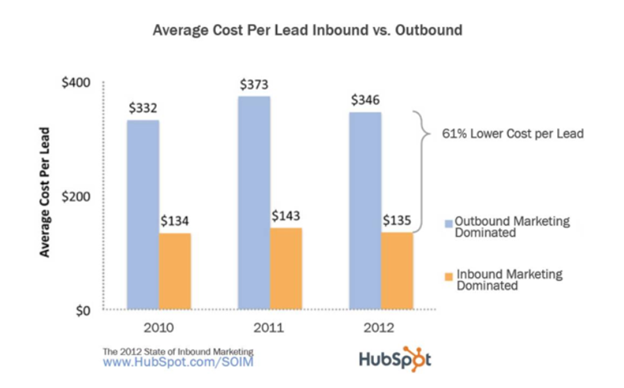
Source: Hubspot
However, you do need to generate that interest to get them to come to your site. That might involve implementing SEO campaigns, for example. Regardless of your approach, use employee scheduling software to set deadlines to get things done.
3. Sales and Marketing Alignment
Some people pit sales against marketing, but it's their alignment that brings results.
The key is to define clear boundaries for each team.
The way your sales and marketing teams work together will depend on the type of products or services you are providing. Ideally, the marketing team should undertake automated marketing strategies for developing the relationship with a lead. This can include using an email software to send out marketing content or engage with people on social media.
Sales leads involve personally interacting with those prospects on a one-to-one basis. For example, that could involve providing product demos or managing sales meetings.
In some instances, sales teams will also generate leads independently of the marketing team. For example, they might achieve this by cold calling companies.
Main Channels For Online Lead Generation
The main digital marketing channels for lead generation are website content, paid ads, social media marketing, email marketing, or by allowing people to try your product or services. That last point is a lot easier to achieve for a service-based business.
Let’s take a brief look at each of these channels in turn.
1. Content
Content plays a role at each stage of the lead generation funnel. Creating great content doesn’t require you to be an artist, but you need to have empathy with your readers. The content you create needs to be relevant to the interests of your leads.
You can create many types of content, from E-books to infographics, whitepapers, and blog posts. Whatever content you create, the principle remains the same. Address the problem your audience faces and provide a solution to those problems.
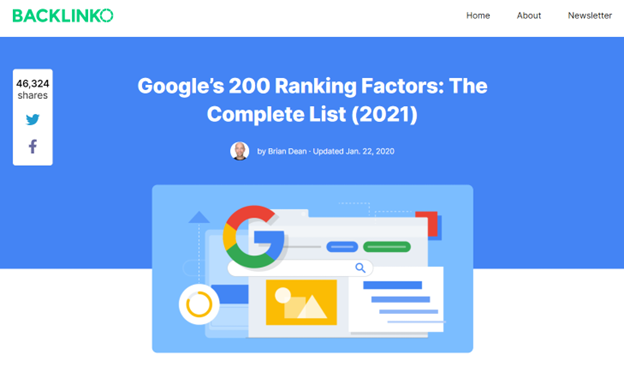
Source: Backlinko
An example of great content is Backlinko’s post on Google’s 200 Ranking factors.
The blog provides in-depth information about how the search engine works. It’s comprehensive. It’s written in a fun and engaging way.
Anyone who reads the blog post won’t just learn a bit more about SEO. They’d be impressed by how much Brian knows and would be tempted to learn more about him. They may even subscribe to his newsletters and become a lead.
Businesses take content marketing seriously because of its effectiveness.
As per the recent survey conducted by SEMRush, 84% of companies out of 1500+ have a content marketing strategy. Content marketing works because it often doesn’t feel like marketing at all.
2. Paid Ads
Paid ads are one of the quickest and best lead generation strategies. As long as you have the money and can turn a profit, you get access to a global audience of millions of people.
There are two broad types of ads. You have the ads that are provided next to search results on Google or another platform. These are intent-based ads. People are searching for a result and either looking to buy something or are interested in a topic.
You can advertise to people as they go through the buying or research process.
Next, you have passive ads. These are ads delivered to people as they browse social media or various websites. With these types of ads, people are rarely in the buying mood. More often than not, they have no intention of making a purchase.
You should use these types of ads towards the top of the lead generation funnel. Ideally, your goal should be to generate a conversion, such as getting people to sign up for your email list.
Somewhere between these two types of ads, you have retargeting ads. You can run retargeting ads at any stage of the lead funnel.
3. Social Media
Organic social media content is mostly used for brand and product awareness and growing an engaged community. At the top of the funnel, people aren’t generally looking for your product. They are using social media for entertainment.
If you’re going to rely on social media at the top of your funnel, you’ll need to create engaging content. That’s hard to do, but it’s certainly possible. Take this piece of content from LinkedIn marketing firm Seed 2 Branch.
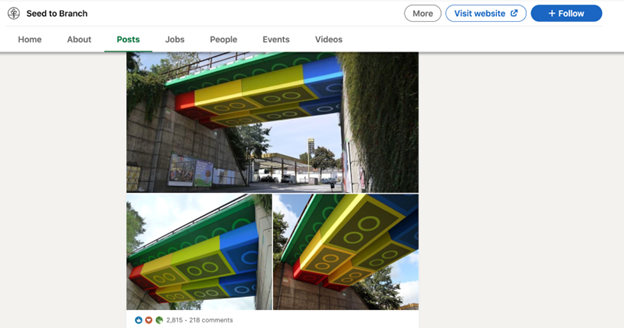
The company consistently generates lots of engagement with its audience on its LinkedIn page. That engagement helps prove to potential prospects that they can create content which people on LinkedIn find interesting. It’s a great way to develop leads.
At the other end of the funnel, you can use social media to create a community of customers. Online Facebook groups, for example, are a great way to bring people together. You can leverage that community to improve relationships with customers. That enables you to increase customer retention and maximize your customer lifetime value.
4. Products
If you are selling a software solution, you can generate leads by offering a trial version of your product at a minimal cost. Or you can offer a full free version of your product to your customers for a limited time period.
You know that your product is of high quality, but your customers don’t. That’s why allowing people to try your product is among the lead generation strategies that work so well. You’re allowing your customers to experience your product instead of just praising its features.
Offline businesses use this strategy all the time. You walk around a home for a home viewing before purchasing a house, for example, and take a test drive of a car before buying the vehicle.
Some online eCommerce companies are experimenting with this approach. For example, Amazon has tested sending product samples as a surprise to people they thought would make a purchase. It’s too early to know if this approach will work, of course.
5. Email
Email marketing is one of the best lead generation strategies. Prospects have given you their email address and shown interest in your product and services. The chances of them turning into customers, then, are quite high.
If you don't have an email list, then you should create one. You can grow a list by offering a valuable resource that your customers will love, such as an ebook or free webinar or a course, in exchange for their email addresses.
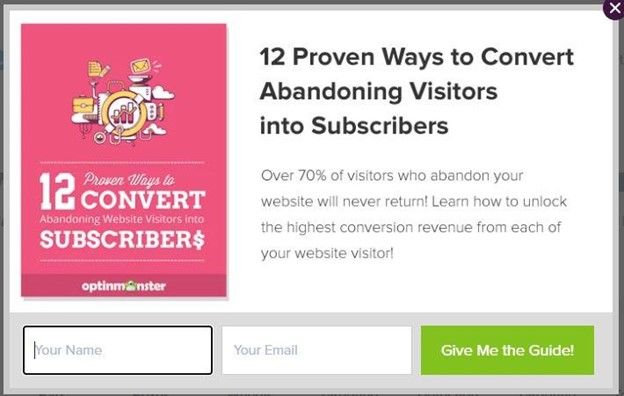
Source: Optinmonster
You can use email marketing at every stage of the lead generation funnel. Email marketing is a great way to engage with new prospects and develop relationships with new customers. You’ll need to segment your list to make the best use of this marketing channel.
Conclusion
Adopting a lead generation strategy is a must because, without a proper plan, your lead generation efforts are going to fail. You must also understand the importance of a lead generation funnel. Identifying the stage of your customer’s buying journey will help you plan your promotional strategies better.
The alignment of the sales and marketing team is also important for the success of your lead generation strategy. Make sure you define clear boundaries and roles for each member of the team to avoid conflict.
Finally, there are several ways to generate leads for your business. We’ve enumerated those in this article. You can choose one or more of them depending on your budget and your product. Whichever strategy you choose, make sure, though, that the product or service you offer is high-quality. Without a great product, even the best of lead generation strategies can fail.




